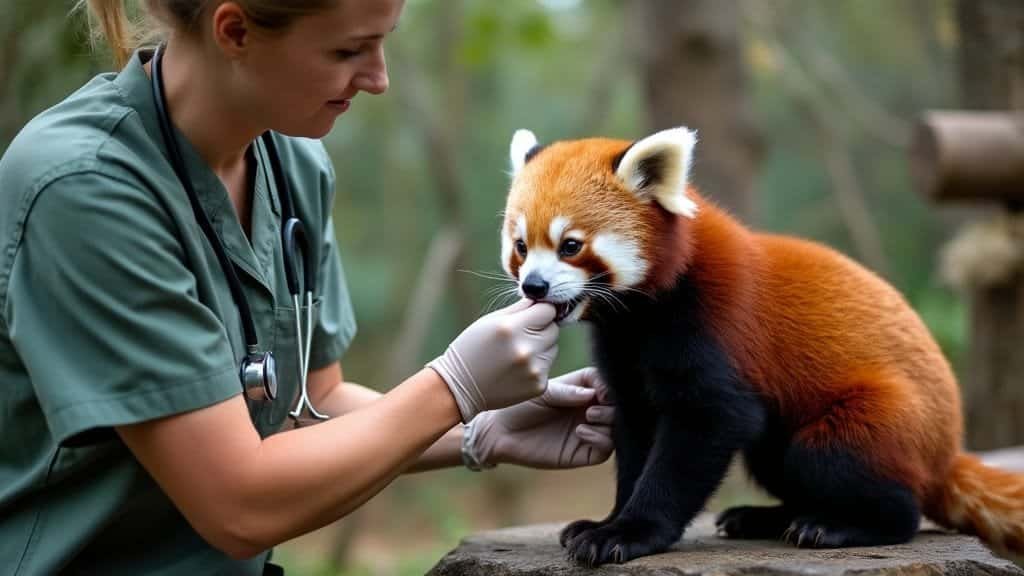Introduction
Zoos play an essential role in the conservation of red pandas by participating in breeding programs, raising public awareness, and contributing to global conservation efforts
Through these initiatives, zoos help increase the population of endangered red pandas, ensure genetic diversity, and educate the public about the importance of protecting these animals and their habitats. In addition, many zoos collaborate with conservation organizations to support habitat protection, rescue efforts, and research into red panda health
This article explores the various ways zoos contribute to the conservation of red pandas, from breeding and education to rehabilitation and global partnerships
The Importance of Zoo Breeding Programs for Red Pandas
Zoo breeding programs play a critical role in the conservation of red pandas, helping to increase their population and maintain genetic diversity, which is essential for the long-term survival of the species
With red pandas listed as endangered due to habitat loss, poaching, and climate change, zoos provide a safe environment for breeding that supports population growth and serves as a genetic reservoir to prevent inbreeding and loss of biodiversity
How Breeding Programs Help Increase Red Panda Populations
Red pandas face significant challenges in the wild, with estimates of fewer than 10,000 individuals remaining across their native habitats in the Himalayas and southwestern China
Zoos have responded to this crisis by developing structured breeding programs that aim to stabilize and even increase the global red panda population
These programs are part of larger, coordinated efforts such as the Species Survival Plan (SSP) in North America and the European Endangered Species Programme (EEP), both of which manage the breeding of red pandas in captivity to ensure healthy, sustainable populations
Breeding programs in zoos carefully pair red pandas based on genetic compatibility, ensuring that breeding results in offspring with a diverse genetic background. By reducing the risk of inbreeding, these programs help maintain the health and viability of future generations
Successful breeding in zoos also provides an important safety net in case wild populations continue to decline, as captive-born red pandas can be used in future reintroduction efforts to bolster wild populations
A notable example of successful zoo breeding comes from the Smithsonian National Zoo, where red panda cubs have been born as part of the SSP. These cubs represent hope for the species, as they contribute to the genetic pool that can be used to support future conservation efforts both in captivity and in the wild
Research by Glatston (2011) highlights the importance of zoos in boosting red panda populations through these breeding initiatives, emphasizing that without the support of zoo-based breeding programs, red pandas would face even more severe population declines
Ensuring Genetic Diversity in Zoo-Based Red Panda Breeding
Maintaining genetic diversity is one of the main goals of red panda breeding programs in zoos. Inbreeding can lead to health problems, reduced reproductive success, and a diminished ability to adapt to environmental changes, which makes genetic diversity critical for the long-term survival of the species
To ensure this diversity, zoos across the world participate in global databases, such as the International Studbook for Red Pandas, which tracks the genetic history of individual red pandas in captivity
Zoo breeding programs carefully monitor the genetic lineage of each red panda to avoid pairing individuals that are closely related. This management system is essential in preventing inbreeding and ensuring that the captive population remains as genetically diverse as possible
The goal is to preserve a broad genetic base that can be used to support the wild population, either through direct reintroduction or by strengthening the gene pool in captive populations
For instance, the SSP and EEP use genetic data to match red pandas from different zoos worldwide, coordinating transfers of red pandas between institutions to optimize breeding success and maintain genetic health
This global collaboration allows zoos to ensure that their breeding efforts are scientifically sound and contribute to the overall genetic robustness of the species
Research by Reed (2004) emphasizes the importance of genetic management in zoo breeding programs, noting that without careful planning, captive populations could suffer from genetic bottlenecks that threaten their long-term viability
Zoo Contributions to Global Breeding and Conservation Networks
Zoos are not working in isolation; they are part of larger, global conservation networks that collaborate on breeding programs, research, and habitat protection for red pandas
Institutions across North America, Europe, and Asia are actively engaged in cooperative breeding initiatives designed to maximize the genetic diversity and overall health of captive red panda populations
These programs are coordinated through organizations such as the Association of Zoos and Aquariums (AZA) and the European Association of Zoos and Aquaria (EAZA), both of which help manage red panda breeding efforts globally
These collaborative efforts allow zoos to pool their resources, share research findings, and exchange animals when necessary to ensure the most successful breeding outcomes. Zoos also work closely with field researchers and conservation organizations, ensuring that their breeding efforts align with broader red panda conservation strategies
By supporting in-situ conservation efforts, such as habitat restoration and anti-poaching initiatives, zoos help bridge the gap between captive breeding and wild population recovery
For example, the Red Panda Network, an organization focused on conserving red pandas in the wild, collaborates with zoos worldwide to integrate zoo-based research and breeding success into larger conservation goals
Through these partnerships, zoos contribute to the overall recovery of red pandas, both by producing captive-bred individuals that could be reintroduced into the wild and by generating public awareness and support for red panda conservation
Educational Initiatives in Zoos for Red Panda Conservation
Zoos play a crucial role in educating the public about red pandas and the importance of conservation. By offering interactive exhibits, educational programs, and outreach efforts, zoos help raise awareness about the challenges red pandas face in the wild, such as habitat loss, poaching, and climate change
These educational initiatives not only engage visitors but also inspire them to support conservation efforts, making zoos a vital tool in spreading awareness and driving public action to protect endangered species like the red panda
How Zoo Education Raises Public Awareness of Red Pandas
Zoos are uniquely positioned to educate the public about red pandas through direct exposure. Visitors can observe red pandas up close, learning about their behaviors, diet, and habitats. This firsthand experience fosters a connection with the animals, making people more likely to support conservation efforts
Many zoos provide informational displays and signs near red panda enclosures, offering facts about the species’ endangered status, threats they face, and the conservation efforts underway to protect them. These displays often highlight the role of habitat loss, poaching, and climate change in red panda population declines, helping visitors understand why conservation is so urgent
Furthermore, zoos frequently host educational talks, workshops, and demonstrations led by zookeepers and conservationists. These sessions allow visitors to ask questions and gain deeper insights into red pandas’ ecology and conservation needs
Through these programs, zoos make complex conservation issues accessible to the public, empowering individuals to take action, whether by supporting conservation organizations, participating in eco-friendly activities, or advocating for environmental protections
Research by Hutchins and Thompson (2008) found that zoos’ educational programs significantly increased visitor knowledge about endangered species and boosted public support for conservation initiatives. The study emphasized that zoos serve as an important educational resource for raising awareness about species like the red panda
Interactive Programs and Red Panda Exhibits in Zoos
To engage visitors more effectively, many zoos have developed interactive programs and exhibits that allow people to connect with red pandas on a deeper level
Some zoos offer behind-the-scenes tours, where participants can learn about the daily care of red pandas, observe feeding sessions, and hear directly from zookeepers about the challenges of maintaining a healthy population in captivity. These immersive experiences provide visitors with a closer look at the conservation efforts happening behind the scenes
In addition, many zoos have developed interactive exhibits that simulate the natural habitats of red pandas, complete with bamboo forests and elevated platforms that allow the animals to exhibit their natural climbing behaviors
These habitats not only provide red pandas with enrichment but also help visitors understand the importance of preserving their wild habitats. By seeing red pandas in environments that mimic their natural settings, visitors gain a better appreciation for the ecosystems these animals depend on and the need to protect these areas in the wild
Some zoos also host special events around International Red Panda Day, a global celebration that raises awareness about red panda conservation. On this day, zoos often offer themed activities, educational talks, and fundraising events, encouraging visitors to contribute to conservation efforts
These events serve as an important platform for engaging the public and spreading the message about red panda conservation on a global scale
Research by Williams and Sherpa (2016) found that interactive programs and exhibits were particularly effective in increasing visitor engagement and fostering a stronger emotional connection to red pandas. The study noted that these experiences often lead to a greater willingness to donate to conservation causes or participate in conservation-related activities
The Impact of Zoo-Based Conservation Education on Visitor Engagement
Zoos’ educational initiatives go beyond simply providing information; they are designed to inspire action. By engaging visitors with captivating stories about red pandas and their struggles in the wild, zoos encourage people to become active participants in conservation
Whether through donations, advocacy, or personal lifestyle changes, zoo visitors are often motivated to support red panda conservation after learning about the species and its challenges
Zoos also partner with schools and community organizations to bring conservation education into classrooms and local events. Many zoos offer school programs that teach students about red pandas and the importance of protecting endangered species
These programs often include hands-on activities, such as building enrichment items for zoo animals or participating in habitat restoration projects, giving students a direct role in conservation efforts
Furthermore, zoos use digital platforms to extend their educational reach beyond visitors who attend in person. Many zoos maintain active social media accounts, websites, and virtual programs that provide educational content about red pandas and other endangered species
These online platforms allow zoos to reach a global audience, spreading awareness about red panda conservation to people who may never have the chance to visit in person
In addition, zoos frequently collaborate with conservation organizations to amplify their impact. For example, many zoos support the Red Panda Network by hosting fundraising events, offering educational materials to visitors, and promoting the organization’s conservation initiatives. By leveraging their educational resources and public reach, zoos play a critical role in supporting global conservation efforts
Research by Sarkar and Wei (2012) demonstrated that zoo-based conservation education programs have a measurable impact on public engagement
The study found that visitors who participated in zoo educational activities were more likely to support conservation organizations, donate to wildlife protection efforts, and adopt environmentally friendly practices in their own lives
Zoo Collaborations with Global Red Panda Conservation Efforts
Zoos are not only key players in red panda breeding and education, but they also contribute significantly to global conservation efforts through partnerships with wildlife organizations and conservation networks
By collaborating with international organizations, participating in research projects, and supporting habitat protection programs, zoos are helping to ensure the survival of red pandas in the wild
These collaborations bridge the gap between in-situ (wild) and ex-situ (captive) conservation, creating a comprehensive approach to red panda conservation
International Partnerships Between Zoos and Conservation Organizations
Zoos worldwide have established partnerships with organizations dedicated to the protection of red pandas in their natural habitats
One of the most prominent examples is the collaboration between zoos and the Red Panda Network, an international conservation organization focused on protecting red pandas in the wild. Zoos provide vital financial support, research data, and public outreach that directly benefit the Red Panda Network’s conservation initiatives
Zoos in North America, Europe, and Asia contribute to red panda habitat conservation by funding anti-poaching patrols, reforestation projects, and community education programs in red panda range countries, such as Nepal and Bhutan
These collaborative efforts are essential for tackling the main threats to red pandas, including habitat loss due to deforestation, illegal hunting, and climate change. By supporting these on-the-ground efforts, zoos are playing a direct role in protecting red pandas where they are most vulnerable
For example, the Red Panda Species Survival Plan (SSP) managed by the Association of Zoos and Aquariums (AZA) not only focuses on breeding red pandas in captivity but also collaborates with conservationists to address threats in the wild. The SSP provides funding and expertise to help protect natural red panda habitats and assists with monitoring wild populations
This coordinated effort between zoos and conservation organizations ensures that red pandas are protected both in captivity and in the wild, contributing to their long-term survival
Research by Glatston (2011) emphasizes the importance of these international collaborations, noting that zoos’ financial contributions and research expertise are critical in supporting conservation efforts that protect red pandas in their natural habitats
How Zoos Support Habitat Protection for Wild Red Pandas
One of the most significant ways zoos contribute to red panda conservation is through habitat protection initiatives
Zoos often partner with conservation organizations to fund habitat restoration and protection projects in regions where red pandas live. These projects focus on preserving and restoring the bamboo forests that red pandas depend on for survival
In Nepal and Bhutan, for example, deforestation and habitat fragmentation are major threats to red pandas. Zoos, in partnership with organizations like the Red Panda Network and World Wildlife Fund (WWF), support reforestation projects that aim to restore degraded habitats and create wildlife corridors
These corridors connect fragmented forests, allowing red pandas to move freely between different areas, which is essential for maintaining healthy populations and genetic diversity in the wild
Zoos also support efforts to involve local communities in habitat protection. By funding community-based conservation programs, zoos help create sustainable alternatives to deforestation, such as eco-tourism and sustainable agriculture. These initiatives provide local people with economic incentives to protect red panda habitats, ensuring that conservation efforts are both effective and sustainable in the long term
In addition to habitat restoration, zoos also contribute to research on habitat use and population monitoring. By providing funding and expertise, zoos support field studies that track red panda movements, assess habitat quality, and identify critical areas for conservation. This research helps inform conservation strategies, ensuring that efforts to protect red pandas are based on the best available science
Research by Sarkar and Wei (2012) highlights the impact of zoo-supported habitat protection initiatives, showing that reforestation and community engagement programs have significantly improved habitat quality in key red panda regions
Research Contributions from Zoos to Red Panda Health and Conservation
Zoos are also essential contributors to red panda health and conservation research. By studying red pandas in captivity, zoos gather valuable data on red panda behavior, diet, reproduction, and health, which can be used to inform conservation strategies for wild populations
This research helps conservationists understand how red pandas respond to environmental changes, such as shifts in food availability due to climate change, and guides efforts to protect and manage wild populations
For example, zoos conduct research on red panda nutrition, providing insights into the dietary needs of the species. In captivity, zoos carefully monitor red panda diets, ensuring they receive the right balance of bamboo, fruits, and supplements
This research has implications for wild populations, as it helps conservationists understand how red pandas cope with seasonal variations in bamboo availability and what alternative food sources may be necessary in times of bamboo scarcity
Zoos also play a crucial role in red panda health monitoring. Through routine health check-ups, zoos gather data on disease prevalence, reproductive health, and genetic disorders in red pandas. This information is shared with conservation organizations, helping to identify potential health threats to wild populations and develop strategies for disease prevention and treatment
In addition, zoos contribute to red panda conservation by participating in population genetics research. By studying the genetic diversity of captive red pandas, zoos help conservationists understand the genetic structure of the species and identify potential risks of inbreeding in both captive and wild populations
This research is critical for maintaining the long-term health and viability of red panda populations, as it ensures that conservation strategies are based on sound genetic principles
Research by Reed (2004) emphasizes the importance of zoo-based research in contributing to global conservation efforts. The study found that zoos’ contributions to health monitoring, behavioral studies, and genetic research are essential for informing conservation strategies for endangered species like the red panda
Zoos’ Role in Red Panda Rescue and Rehabilitation
Zoos play a crucial role in rescuing, rehabilitating, and sometimes reintroducing red pandas into the wild. As red pandas face numerous threats such as habitat destruction, poaching, and illegal wildlife trade, zoos collaborate with conservation organizations and local authorities to provide medical care, rehabilitation, and a safe environment for red pandas in need
Rescue and rehabilitation efforts are an integral part of the broader conservation strategy, helping to support both individual red pandas and the species as a whole
Zoo Involvement in Red Panda Rescue Operations
Red pandas rescued from dangerous situations—such as being captured for illegal wildlife trade or injured due to habitat encroachment—are often taken in by zoos or wildlife rescue centers
Zoos have the necessary resources, veterinary expertise, and facilities to care for these animals and help them recover. In many cases, zoos collaborate with wildlife protection agencies, such as forest departments in red panda range countries, to ensure the safe transport and treatment of rescued red pandas
Rescued red pandas typically undergo a thorough health evaluation upon arrival at a zoo. This includes assessing any injuries, checking for diseases or parasites, and evaluating their overall fitness
Zoos provide the necessary medical treatment and care for red pandas to recover from trauma, illness, or injuries sustained in the wild. The goal is to rehabilitate these animals to the point where they can either be returned to the wild or live in captivity under optimal conditions
In Nepal, the Red Panda Network works closely with local communities and zoos to rescue red pandas that have been displaced by habitat loss or captured by poachers. Zoos play a vital role in providing immediate care and long-term rehabilitation for these animals, ensuring that they have the best chance of survival
Research by Yonzon and Hunter (1991) highlighted the importance of collaboration between zoos and local authorities in red panda rescue operations, emphasizing that the expertise and resources zoos provide are critical to the success of these efforts
How Zoos Help Rehabilitate and Reintroduce Red Pandas into the Wild
Rehabilitation is a key part of the process for rescued red pandas, particularly for individuals that may be candidates for reintroduction into the wild. Zoos carefully evaluate the physical and behavioral condition of rescued red pandas to determine whether they are suitable for release
Rehabilitation programs focus on preparing the red pandas for life in the wild, which includes ensuring that they can forage, climb, and exhibit natural behaviors that are essential for survival
The process of reintroducing red pandas into the wild is complex and requires careful planning. Zoos often collaborate with wildlife conservation organizations to select appropriate release sites, taking into account factors such as habitat quality, food availability, and the presence of other red panda populations
Before release, red pandas may be placed in semi-wild enclosures that simulate their natural habitat, allowing them to adjust and refine their survival skills in a controlled environment
Once a red panda is released into the wild, zoos and conservation organizations continue to monitor its progress using tracking devices, such as radio collars or GPS trackers. This post-release monitoring is crucial for assessing the success of the reintroduction and ensuring that the red panda can thrive in its new environment
If any issues arise, such as difficulties with finding food or avoiding predators, conservationists can intervene to provide additional support
An example of a successful reintroduction program comes from the Padmaja Naidu Himalayan Zoological Park in India, which has been involved in rehabilitating and reintroducing red pandas into the Singalila National Park
The zoo’s breeding and rehabilitation efforts, combined with careful monitoring of reintroduced individuals, have contributed to the growth of the wild red panda population in the region
Research by Sarkar and Wei (2012) showed that rehabilitation and reintroduction programs, when carried out in collaboration with zoos, significantly improve the chances of red panda survival in the wild, especially in areas where populations have been diminished due to poaching or habitat destruction
Challenges and Successes in Zoo-Based Red Panda Rehabilitation Programs
While zoo-based red panda rescue and rehabilitation programs have seen many successes, they also face significant challenges. One of the main challenges is ensuring that red pandas rescued from captivity or injured in the wild can adapt to life in their natural habitat
Red pandas raised in captivity or kept in poor conditions by wildlife traffickers may struggle to develop the necessary survival skills, such as foraging for bamboo or avoiding predators. Zoos must carefully assess each individual’s ability to survive in the wild before considering reintroduction
Another challenge is the limited availability of suitable habitats for reintroduction. As red panda habitats continue to be threatened by deforestation and human encroachment, finding safe release sites with sufficient resources is increasingly difficult. Zoos must work closely with conservation organizations and governments to identify and protect suitable habitats for reintroduced red pandas
Despite these challenges, zoo-based rehabilitation and reintroduction programs have seen notable successes. In many cases, rescued red pandas that have been rehabilitated by zoos have successfully re-entered the wild and contributed to the recovery of local populations
These programs have also raised public awareness about the threats facing red pandas, leading to greater support for conservation efforts
Zoos like the Chester Zoo in the UK and the Smithsonian’s National Zoo in the U.S. have both contributed to red panda rescue and rehabilitation efforts, providing expertise, funding, and research to support these critical programs
Their success stories serve as models for other zoos and conservation organizations looking to expand their rescue and rehabilitation capabilities
Conclusion
Zoos contribute significantly to the conservation of red pandas through various roles, including breeding programs, education, global collaboration, and rescue efforts. Their breeding initiatives ensure the long-term survival of the species by maintaining genetic diversity and increasing red panda populations, while their educational programs raise public awareness and inspire action for red panda conservation
Additionally, zoos collaborate with international organizations to protect and restore habitats, ensuring that wild red panda populations have a safe and sustainable environment in which to thrive
Zoo-led rescue and rehabilitation efforts also play a crucial part in red panda conservation. Zoos provide the medical care and rehabilitation required for injured or illegally captured red pandas, giving them a chance to recover and potentially be reintroduced into the wild
Through collaboration with conservationists and local communities, zoos help build stronger conservation networks that safeguard red pandas both in captivity and in their natural habitats
The combined efforts of zoos, conservation organizations, and local communities are essential for ensuring the future of the red panda. By continuing to support breeding, education, research, and habitat protection, zoos are helping to protect this endangered species from the many threats it faces in the wild
Ultimately, the role of zoos in red panda conservation goes beyond their enclosures, making a significant and lasting impact on the survival of the species and the ecosystems they inhabit









